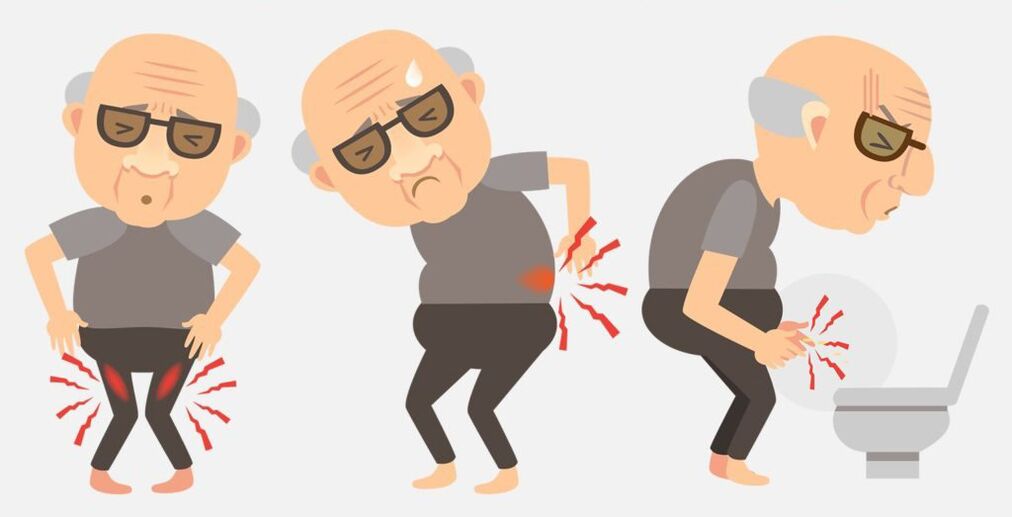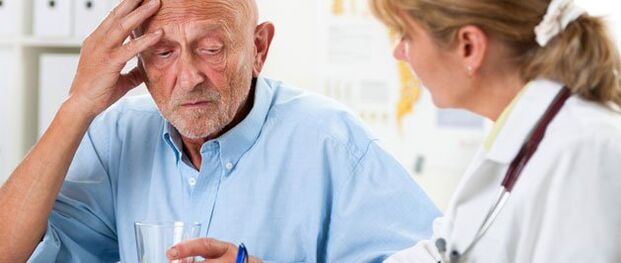The symptoms of prostatitis in men are not characteristic and specific, as they may appear at first glance. That is why in modern urology and andrology, infertility is increasingly diagnosed among men of the most active reproductive layer - from 25 to 40 years. The prostate gland in men is an organ that performs several functions: barrier, regulates blood clotting, endocrine, reproductive, sexual (sexual), the role of the bladder sphincter. The signs of prostatitis in men and its symptoms are varied, especially in the chronic form - it covers all organ functions and is often difficult to diagnose.
Symptoms of acute prostatitis in men

What symptoms of prostatitis in men should make you pay attention to them and go to the doctor? Every man, especially at a young and sexually active age, needs to know about the signs of inflammation of the lower genital tract and the possibility of emerging prostate disease clinics. Many young people postpone a visit to a urologist with the thought that the disease belongs to an older age group.
important.
Inflammation of the prostate is based on a complex of factors that begin to act precisely at the age of 20-30 years.
- Sexually transmitted infections are the first thing that triggers an active or slow inflammatory process. Chlamydia, mycoplasma infections, gonorrhea, trichomoniasis, gardnerellosis initiate urethritis, in which the development of inflammation of the glands is possible. The herpes simplex virus, human papilloma, CMV, if it does not cause inflammation of the glands, then significantly worsens the course of STIs and "paves the way" for bacteria in organ tissues. Against the background of genital infections, opportunistic flora (staphylococci, Escherichia coli) often lead to prostate disease. When diagnosed, mixed flora is often found.
- Work accompanied by long sitting is one of the factors that trigger the disease. The dangers or habits of such work adversely affect prostate health.
- Sex life arrhythmias - rare or random, psychological problems that cause delay or absence of ejaculation, erectile dysfunction, frequent masturbation - significantly disrupt the balance of arterial and venous blood flow in the glands.
- The effects of cold on the lumbar region, abdomen and legs - winter sports and recreation, occupational hazards associated with hypothermia, trigger irreversible changes in glandular tissue.
Sexually transmitted infections, chronic hypothermia, venous blood stasis and prostate secretions lay the foundation for the formation of chronic prostatitis. . . The inflammatory symptoms of prostatitis in various forms are combined into three syndromes: painful, sexual and disurik (urinary disorders). The priority of one of them is the reason for a visit to the doctor - urologist, sexologist, therapist or surgeon. The vigilance and competence of the physician will determine the speed of the healing process.
Acute prostatitis, symptoms of which are observed after or concurrently with active genital infection, is characterized by the following:
- Discomfort and pain when urinating.
- Cutting at the beginning or end of urination.
- Frequent and false urging to use the toilet.
- Pain around the anus, especially when sitting.
- Pain during defecation, fullness in the rectum.
- Mucopurulent discharge from the urethra.
- Abdominal pain spreads to the thighs, scrotum, back.
- Fever.
- Sexual dysfunction.
Each patient has a different level of symptom severity. Also, only certain symptoms can dominate. But often the acute process continues with few symptoms, which ensures frequent chronicity and an increase in the number of cases of chronic prostatitis identified.
The first signs of prostatitis
The onset symptoms of prostatitis occur in young men under the name of acute respiratory infections or in the form of classic genital infections. Depending on the type of pathogen, the signs of the acute process can be bright or extinguished.
Symptoms of prostatitis in men, initiated by gonococci, Staphylococcus aureus, Escherichia coli, as well as with nosocomial infections (after manipulation of the urinary tract) are characterized by the following:
- The patient is suddenly attacked by a chill, which lasts from half an hour to two hours and ends with sweating.
- The temperature rises to 38 - 40 ° C.
- Characterized by weakness, severe weakness.
The first symptoms of prostatitis in men may not be accompanied by characteristic pain in the pelvic, rectal and groin areas.. . . Also, sexual weakness is not a feature. In contrast, the first stage of catarrhal disease is indicated by excessive excitement and premature ejaculation.
important.
Urogenital chlamydia, which often causes chronic prostatitis, initially has only mild dissipated symptoms.
How is prostatitis manifested in men, which is initiated by the entry of hematogenous or lymphogenic flora into prostate tissue? The types of diseases that accompany general somatic infectious diseases (sinusitis, sore throat, pneumonia, abscesses, pustular skin disease) may not be noticed by the patient. Against the background of the underlying disease, the temperature rises again and the symptoms of intoxication increase, the phenomenon of mild diarrhea and abdominal pain may develop.
Symptoms of chronic prostatitis in men

Chronic bacterial or viral prostatitis, congestive or infectious, the symptoms of which vary, are united by the fact that the inflammatory process, although caused by different trigger factors, leads to three basic manifestations:
- Pain syndrome.
- Disorders of urination.
- Sexual dysfunction.
Pain symptoms with prostatitis are also divided into three types:
- Extragenital - pain in the rectum, lower back, abdomen is characteristic.
- Pelvis - pain symptoms do not appear as such, but there is itching in the anus, tingling, paresthesia, neurosis, excessive sweating - this is due to the involvement of the pelvic nerve plexus in the process.
- Genitals - pain in the scrotum, lumbago in the testicles, groin and perineum.
- mixed.
Pain symptoms in prostatitis form a concept like "chronic pelvic pain syndrome in men. "
Symptoms of chronic forms of inflammation of the prostate gland are accompanied by violations and suppression of erections, ejaculation, and decreased libido. Against this background, neurosis -like syndromes are formed, which take place according to the sympathetic or parasympathetic type. The first is characterized by heart attack, fever, subfebrile state of the evening, sudden changes in mood, inattention. For the latter - daytime drowsiness, fatigue, insomnia at night, hypochondria, sweating, weight gain, lumps in the throat, excessive saliva.
Among the disurik phenomena, there is an increase in urination, difficulty emptying the bladder, dripping, and flow fatigue. Such signs have a clear resemblance to adenomas, which sometimes complicate the diagnosis.
important.
Chronic prostatitis in men after 45 years often occurs concurrently with prostate hyperplasia.
In the chronic form, spermatorrhea and prostatorrhea are observed - secretion of prostate secretions from the urethra in combination with seminal fluid due to organ atonia.
Prostatitis without symptoms
Inflammation of the prostate is not always symptomatic. Often, a man learns about the disease, for example, when he performs ultrasound diagnostics while planning a child. They found calcification in prostate tissue, erased ducts, enlargement or reduction of glands, sclerosis, impaired blood flow according to Doppler sonography, varicose veins of the prostate plexus and small pelvis.
Symptomatic prostatitis develops in young men after undergoing genital infections, in particular, urogenital chlamydia and mycoplasmosis.Especially often asymptomatic prostatitis is recorded after inadequate and incomplete treatment of the disease. Often, when examining sperm, a decrease in the number of germ cells, a decrease in active motile cells, agglutination, and a decrease in lecithin grains are found. Periodic sexual failure is possible, which the man does not care about.

Symptoms of worsening prostatitis
The severity of chronic prostatitis develops when exposed to adverse provoking factors - general somatic diseases, hypothermia, irregular sexual activity, alcohol abuse, exacerbation of infectious diseases of the genitourinary organs, rectum.
The symptoms of exacerbation of prostatitis in men are similar to the onset of the disease. Temperature rise, general lethargy, fatigue, weakness, chills come to the fore. Pain in the anus, fullness in the rectum, lumbago in the groin, perineum is increasing. Sexual dysfunction and nervousness also get worse. When going to the toilet, the patient noted difficulty and increased urination, weakened flow, pain.
Travel characteristics of some types of prostatitis
How is prostatitis manifested in men in its various types? Conventionally, several types of disease are distinguished, depending on the process that takes place: infectious, bacterial, stagnant, purulent.
Infectious and bacterial prostatitis
This concept encompasses several forms of disease nosology, or rather differentiates according to the type of pathogenic pathogen. Infectious prostatitis, a symptom that can only be caused by pathogenic bacteria and viruses, can be initiated by a sexually transmitted and opportunistic pathogenic flora. Conditional pathogenic microorganisms that normally inhabit the male genitourinary tract cause disease only by unfavorable factors. Often, when seeding semen and urine, Escherichia coli, staphylococcus, enterococcus are found. This is bacterial prostatitis.
Infectious prostatitis is recorded very much in young people.This type of inflammation of the prostate gland most often causes chronic and leads to infertility.
The clinical picture is characterized by the greatest brightness with gonorrhea, and with chlamydia, mycoplasmosis and opportunistic pathogens, the symptoms are limited, therefore, it often leads to chronic prostatitis.

Purulent prostatitis
The pyogenic flora is represented by gonococci, Pseudomonas aeruginosa, Escherichia coli, methicillin -resistant Staphylococcus strains. These microorganisms secrete a number of destructive enzymes, characterized by aggression against prostate tissue, and therefore initiate purulent fusion.Often, purulent prostatitis ends with abscesses, phlegmon, paraprostatitis, paraproctitis.
The purulent process is often initiated by bacteria that have entered the prostate gland in the following ways:
- From purulent foci in other organs.
- For medical intervention on the genitourinary organs. The hospital flora is characterized by a wide range of resistance to antibiotics, therefore it leads precisely to purulent prostatitis.
Purulent prostatitis, the most obvious symptom, often leads to complications: urinary fistulas and intestinal vesicles. And even such bacteria easily penetrate the ascending pathways to the kidneys, pelvis and chalices, causing their chronic inflammation.
Congestive prostatitis
The isolated course of this type of disease can be said to be excluded, because against the background of the stagnant process, the microbial flora is attached and this type acquires an infectious form of course. Often, urologists make such a diagnosis if no bacteria are isolated in the biomaterial inoculation. As a rule, the analysis carried out after 2-3 weeks will already give positive results for the bacterial flora.
Venous blood stagnation is often observed with varicose veins, rectal pathology, pelvic tumors, hypodynamia. Violation of the outflow of prostate secretions, most often observed in sexual dysfunction and irregular sexual activity, leads to stagnation and a prerequisite for inflammation.Congestive prostatitis, the symptoms of which coincide with infectious inflammation, are closely related and follow each other.Symptoms will be complemented by varicose veins and rectal lesions.
Obviously, in the chronic form the manifestations of prostatitis may be nonspecific in nature, requiring a thorough comprehensive diagnosis.
important.
Any sign of a genital infection in men should be a reason to contact a urologist or venereologist for treatment.
Self-medication or neglect of the condition can serve as an impetus for the formation of a chronic form.
























